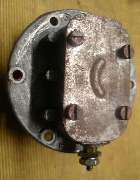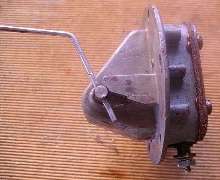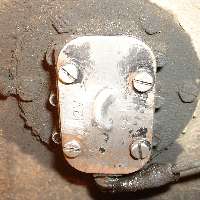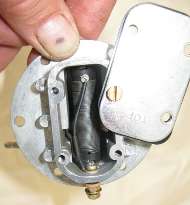The MGA With An Attitude
FUEL SENDER UNIT - General Notes -- FG-110
If your fuel sender unit goes bad, I recommend this order of preference for possible repair:
1,) Repair the original one, - See ET-214 for rebuild.
2.) Procure an original style replacement part.
And a far distant third:
3.) Use an aftermarket part as a last resort.

 A recent quote from our noble friend John Twist at University Motors: "We always try to repair the original one, as the current replacements are so bad". Original units have a metal float, fine resistance wire at 0 to 70 ohms, dual wipers, and were successfully installed using a cork gasket. (Thanks to Russell James Goebel for the pictures).
A recent quote from our noble friend John Twist at University Motors: "We always try to repair the original one, as the current replacements are so bad". Original units have a metal float, fine resistance wire at 0 to 70 ohms, dual wipers, and were successfully installed using a cork gasket. (Thanks to Russell James Goebel for the pictures).
 Current aftermarket parts may have a plastic float, coarser resistance wire (maybe different resistance), single wiper, and may be supplied with a thick paper or elastomer gasket. Mounting holes may need to be filed for alignment of screws. In some cases the inner metal shell may be a bit too large for the hole in the tank and may require considerable filing to fit. The coarse resistance wire and single wiper may cause erratic reading of the gauge, and/or may fail soon after installation. Picture here on left is an original unit with closely wound fine wire and dual wipers. On right is an aftermarket unit with loosely wound coarse wire and single wiper. This one failed when the loosely spaced wire coils were moving up and down the bobbin to cause erratic and intermittent output on the gauge. (Thanks to Pat Harris for these pictures).
Current aftermarket parts may have a plastic float, coarser resistance wire (maybe different resistance), single wiper, and may be supplied with a thick paper or elastomer gasket. Mounting holes may need to be filed for alignment of screws. In some cases the inner metal shell may be a bit too large for the hole in the tank and may require considerable filing to fit. The coarse resistance wire and single wiper may cause erratic reading of the gauge, and/or may fail soon after installation. Picture here on left is an original unit with closely wound fine wire and dual wipers. On right is an aftermarket unit with loosely wound coarse wire and single wiper. This one failed when the loosely spaced wire coils were moving up and down the bobbin to cause erratic and intermittent output on the gauge. (Thanks to Pat Harris for these pictures).
A paper gasket would require a sealant, but few sealants are functional with modern motor fuels. Elastomer gaskets are commonly known to swell and/or quickly deteriorate in contact with modern motor fuels, and no sealant can help that problem. It is highly recommended to use a cork gasket, even if you have to make your own, and no sealant is required with cork. Keep the screw holes in the gasket small as the gasket needs to seal around the screw threads.
Addendum January 2007:
Apparently there are two different sender units commonly found on the MGA. These two are physically and electrically interchangeable
 and may have been factory installed under the same BMC part number. Perhaps there may have been some minor physical changed in production of the parts during the production run period of the MGA. It is not often that I wash paint off of a perfectly good part of my car just for inspection, but here it is. My car is from August 1957 production. The part number stamped on the sender unit is 86112. The other part number is FT5300 as seen (vaguely) in the picture at top of page. David Grahame reports having found at least two of each of these part numbers on used MGA fuel tanks. The working resistance may also be in 0-85 ohm range rather than 0-70 ohms, but this should not be a problem if the gauge is calibrated to match.
and may have been factory installed under the same BMC part number. Perhaps there may have been some minor physical changed in production of the parts during the production run period of the MGA. It is not often that I wash paint off of a perfectly good part of my car just for inspection, but here it is. My car is from August 1957 production. The part number stamped on the sender unit is 86112. The other part number is FT5300 as seen (vaguely) in the picture at top of page. David Grahame reports having found at least two of each of these part numbers on used MGA fuel tanks. The working resistance may also be in 0-85 ohm range rather than 0-70 ohms, but this should not be a problem if the gauge is calibrated to match.
Addendum June 2010:
This one appears to be better quality. The resistance is not quite right at 20-100 ohms,
 but it is likely that the gauge can be recalibrated to work right except it may not go all the way to the "E" mark. That is, you may run out of gas while the gauge still shows 1/4 tank.
but it is likely that the gauge can be recalibrated to work right except it may not go all the way to the "E" mark. That is, you may run out of gas while the gauge still shows 1/4 tank.
 On 02 June 2010, Kevin Garner in West Midlands, UK wrote: "Having returned a sender unit back to MGOC - due to poor quality, the Brown and Gammon unit is expensive but appears robust. The picture shows the winding and what appears to be a much stronger connection to the brass connecting stud. Not sure it's entirely as original specification as my measurements were 20 ohms at empty and 100 ohms set at full". On 02 June 2010, Kevin Garner in West Midlands, UK wrote: "Having returned a sender unit back to MGOC - due to poor quality, the Brown and Gammon unit is expensive but appears robust. The picture shows the winding and what appears to be a much stronger connection to the brass connecting stud. Not sure it's entirely as original specification as my measurements were 20 ohms at empty and 100 ohms set at full".
Since this one does not go to zero at "Empty", it might be possible to change the signal range by bending the float arm near the pivot point. The idea is to make the contact wiper inside the housing use a different part of the resistor coil. If so, perhaps it could be adjusted to rum from 0-80 ohms.
|